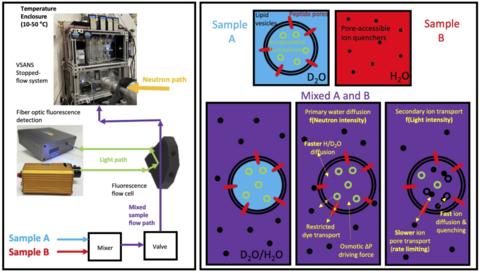CHRNS: Stopped flow capabilities

Principle
In this device solutions are forced into a specially designed mixing chamber. After a time, perhaps as short as a few ms, the solution is pushed into the sample cell at a time recorded using the master clock. Thus, this device will allow automated sample preparation to be done on a time scale matching those accessible to vSANS and CANDOR and provide the time resolution necessary to characterize the kinetics of, for example, the formation of biocomplexes.
The in-house-built stopped flow apparatus has improved its time resolution from ~3 seconds to ~400 ms.
Accelerated Implementation for FY-24
- Temperature-controlled (10-50 °C)
- 2 Syringe Pumps (for 2 sample injections)
- Pressure sensors – automatic overpressure shutdown
- Selector valves for fluid path control
- High-speed mixer
- 2 sample cells
- 2 Pressurized lines for solvent rinses & drying
- UV-Vis spectrometer (multi-modal data, NEW for FY23)
- Dead Volume: ~ .75 mL
- Dead Time: ~ 400 ms
- SECoP controlled with GUI and indicator panel (https://gitlab.nist.gov/gitlab/ces7/sfsans)
- Commercial cell (Biologic)
- Also available a commercial Biologic stopped flow system (SMF-4000, 30 ms deadtime, low viscosities)
Many thanks to the party of interested scientists that provided feedback and prioritized capabilities:
Lilo Pozzo – Washington; Ron Jones – NIST; Norm Wagner – Delaware; Drew Marquardt– Windsor; Sarah Rodgers–RAL; Adrian Rennie– Uppsala Andy Church–RAL; Lionel Porcar– ILL
Contacts
-
(301) 975-8544
Created February 4, 2023, Updated May 9, 2025

